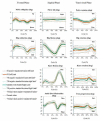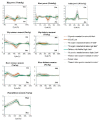Musculoskeletal and Gait Characteristics in Patients with Stickler Syndrome: A Cross-Sectional Study
- PMID: 36553338
- PMCID: PMC9777477
- DOI: 10.3390/children9121895
Musculoskeletal and Gait Characteristics in Patients with Stickler Syndrome: A Cross-Sectional Study
Abstract
Background: Stickler syndrome (SS) is a connective tissue disorder of fibrillary collagen with very variable clinical manifestations, including premature osteoarthritis and osteopenia. This musculoskeletal alteration may affect gait maturity or produce strength difficulties.
Objective: Our aim was to describe the musculoskeletal characteristics, bone stiffness, gait kinematics, and kinetics of SS patients.
Methods: This is a cross-sectional study of children and youngsters with SS recruited by telephone calls through the Spanish SS Association. All participants underwent an analysis of musculoskeletal characteristics, including a 3D gait analysis.
Results: The sample included 26 SS patients, mainly boys (65.4%) with a median age of 11 (IQR 5-14). The manual muscle testing was normal in 88.5% of patients. The median distance covered in the 6-min walking test was 560.1 ± 113.4 m. Bone stiffness index scores were 70.9 ± 19.7 for children under 10 years and 88.3 ± 17.5 for children older than 10 years. The gait indicators GPS and GDI were: 7.4 ± 1.9 and 95.3 ± 9.7, respectively, for the left side and 6.8 ± 2.0 and 97.7 ± 9.5 for the right side, respectively.
Conclusions: In our series of patients with SS, we found muscle-articular involvement does not have a high impact on strength or gait problems. More work is needed to understand the effect of SS on the musculoskeletal system.
Keywords: 3D gait analysis; Stickler syndrome; collagenopathy; quantitative ultrasound stiffness index.
Conflict of interest statement
The authors declare no conflict of interest.
Figures
Similar articles
-
Quality of Life in Children and Adolescents with Stickler Syndrome in Spain.Children (Basel). 2022 Aug 19;9(8):1255. doi: 10.3390/children9081255. Children (Basel). 2022. PMID: 36010145 Free PMC article.
-
Pediatric generalized joint hypomobility and musculoskeletal complaints: a new entity? Clinical, biochemical, and osseal characteristics.Pediatrics. 2004 Apr;113(4):714-9. doi: 10.1542/peds.113.4.714. Pediatrics. 2004. PMID: 15060217
-
Stickler syndrome associated with epilepsy: report of three cases.Eur J Pediatr. 2015 May;174(5):697-701. doi: 10.1007/s00431-015-2514-8. Epub 2015 Mar 27. Eur J Pediatr. 2015. PMID: 25809783
-
Stickler Syndrome: A Review of Clinical Manifestations and the Genetics Evaluation.J Pers Med. 2020 Aug 27;10(3):105. doi: 10.3390/jpm10030105. J Pers Med. 2020. PMID: 32867104 Free PMC article. Review.
-
The impact of ankle-foot orthosis stiffness on gait: A systematic literature review.Gait Posture. 2019 Mar;69:101-111. doi: 10.1016/j.gaitpost.2019.01.020. Epub 2019 Jan 15. Gait Posture. 2019. PMID: 30708092
References
-
- Stickler G.B., Belau P.G., Farrell F.J., Jones J.D., Pugh D.G., Steinberg A.G., Ward L.E. Hereditary Progressive Arthro-Ophtalmopathy. Mayo Clin. Proc. 1965;40:433–455. - PubMed
-
- Matute G.R., Alonso E.R. Síndrome de Stickler. Semin. Fund. Esp. Reumatol. 2009;10:83–86. doi: 10.1016/S1577-3566(09)72129-3. - DOI
-
- Richards A.J., Baguley D.M., Yates J.R.W., Lane C., Nicol M., Harper P.S., Scott J.D., Snead M.P. Variation in the Vitreous Phenotype of Stickler Syndrome Can Be Caused by Different Amino Acid Substitutions in the X Position of the Type II Collagen Gly-X-Y Triple Helix. Am. J. Hum. Genet. 2000;67:1083–1094. doi: 10.1016/S0002-9297(07)62938-3. - DOI - PMC - PubMed
Grants and funding
LinkOut - more resources
Full Text Sources



